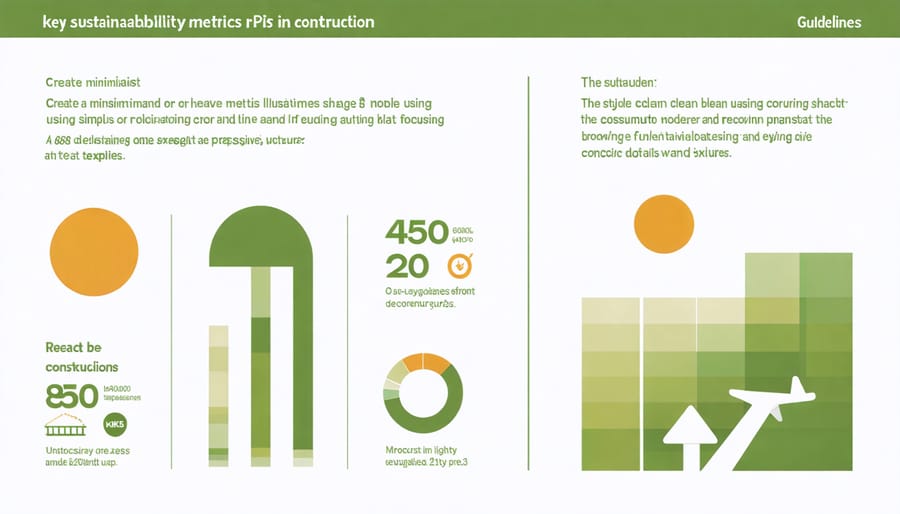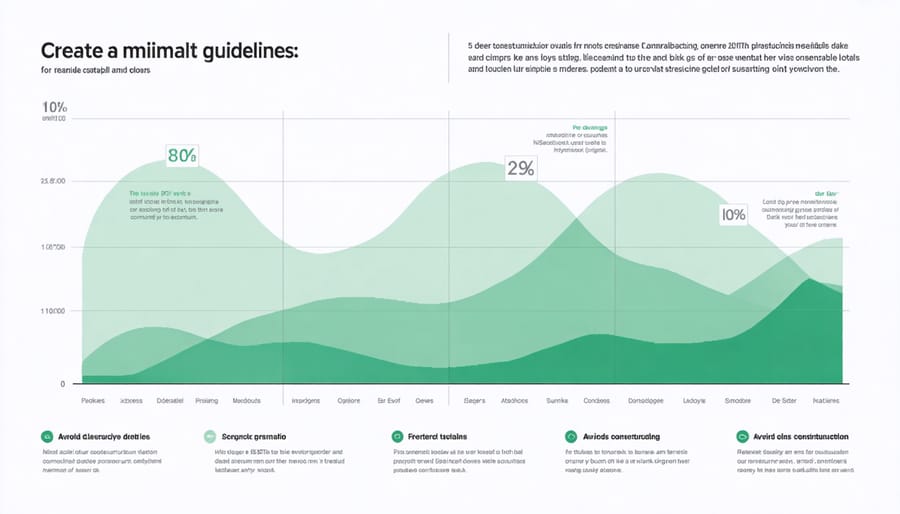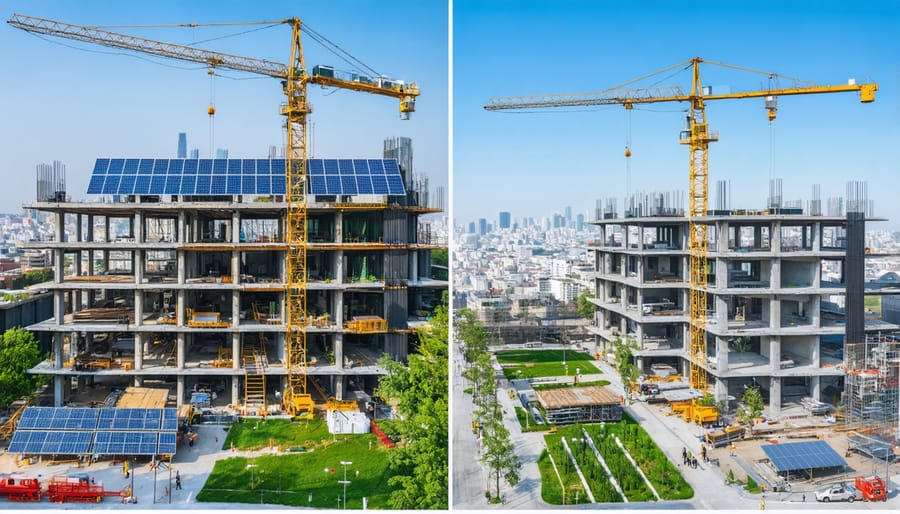In today’s construction landscape, a robust project sustainability plan serves as the cornerstone of successful long-term development, driving both environmental responsibility and financial viability. Leading construction firms recognize that sustainability planning transcends basic environmental compliance, encompassing comprehensive strategies for resource optimization, waste reduction, and long-term operational efficiency. By integrating sustainable practices from the project’s inception, organizations can achieve up to 30% reduction in operational costs while meeting increasingly stringent environmental regulations and stakeholder expectations.
A well-structured sustainability plan addresses three critical dimensions: environmental stewardship, economic feasibility, and social responsibility. This integrated approach ensures projects not only minimize their ecological footprint but also maximize return on investment through reduced energy consumption, enhanced material efficiency, and improved building performance. Industry leaders implementing comprehensive sustainability plans consistently report higher project success rates, increased stakeholder satisfaction, and stronger competitive positioning in the market.
The construction sector’s pivot toward sustainability isn’t just an environmental imperative—it’s a business necessity. As regulatory requirements tighten and clients increasingly demand green building solutions, organizations without robust sustainability plans risk falling behind in a rapidly evolving market. This guide explores essential components of effective project sustainability planning, offering practical strategies for implementation across various construction contexts.
Core Components of an Effective Sustainability Plan
Environmental Impact Assessment
Environmental Impact Assessment (EIA) forms a crucial component of any project sustainability plan, requiring systematic evaluation of potential environmental effects throughout the project lifecycle. The assessment begins with establishing baseline environmental conditions and identifying key impact areas, including air quality, water resources, biodiversity, and waste management. Project teams must implement comprehensive monitoring systems to track and measure environmental indicators, facilitating data-driven decisions for reducing building emissions and resource consumption.
The assessment process typically employs both qualitative and quantitative methods, including carbon footprint analysis, life cycle assessment (LCA), and environmental risk matrices. These tools help identify critical environmental aspects requiring mitigation measures and provide measurable benchmarks for improvement. Modern EIA practices increasingly incorporate digital monitoring systems and real-time data analytics to ensure continuous environmental performance optimization.
Key mitigation strategies should be developed based on the assessment findings, prioritizing actions that deliver the greatest environmental benefits while remaining economically viable. Regular reassessment and adjustment of these strategies ensure the project maintains its environmental targets throughout its operational phase.
Resource Efficiency Strategy
An effective resource efficiency strategy focuses on minimizing waste while maximizing the value derived from materials, energy, and water throughout the project lifecycle. The implementation of sustainable construction materials forms the foundation of this approach, complemented by smart energy management systems and water conservation measures.
To optimize material usage, establish a comprehensive inventory management system that tracks material flow from procurement to installation. Implement just-in-time delivery practices to reduce storage requirements and potential waste. Consider modular construction techniques where appropriate to minimize off-cuts and excess materials.
Energy efficiency measures should include the strategic use of natural lighting, high-efficiency HVAC systems, and automated controls. Install smart meters to monitor energy consumption patterns and identify opportunities for reduction. For water conservation, incorporate low-flow fixtures, rainwater harvesting systems, and greywater recycling where feasible.
Regular monitoring and adjustment of resource consumption patterns ensure optimal efficiency throughout the construction phase. Document best practices and lessons learned to inform future projects and contribute to continuous improvement in resource management.

Implementation Framework
Stakeholder Integration
Successful project sustainability requires active engagement and commitment from all key stakeholders throughout the project lifecycle. Begin by identifying essential stakeholders, including clients, contractors, suppliers, local communities, regulatory bodies, and end-users. Early involvement allows for better integration of sustainability goals and ensures all parties understand their roles and responsibilities.
Establish clear communication channels and regular touchpoints to maintain stakeholder engagement. Regular workshops, progress meetings, and feedback sessions create opportunities for stakeholders to voice concerns and contribute ideas. This collaborative approach helps identify potential challenges early and develop effective solutions collectively.
Document stakeholder requirements and sustainability expectations in formal agreements. Include specific sustainability targets, reporting mechanisms, and accountability measures in contracts and project documentation. This creates a clear framework for stakeholder participation and ensures alignment with project sustainability objectives.
Consider implementing a stakeholder management system to track engagement levels and monitor participation. Regular stakeholder surveys and assessments help measure satisfaction and identify areas for improvement. Success stories from similar projects can demonstrate the benefits of stakeholder integration and encourage continued commitment.
Building strong relationships with suppliers and subcontractors is particularly crucial. Work closely with them to establish sustainable procurement practices and ensure compliance with environmental standards. Provide training and resources when necessary to help stakeholders meet sustainability requirements and contribute effectively to project goals.
Performance Metrics
Performance metrics form the backbone of any successful project sustainability plan, enabling teams to measure progress and demonstrate value effectively. Key Performance Indicators (KPIs) should align with both environmental goals and project objectives, creating a balanced framework for assessment.
Essential sustainability metrics include energy efficiency (measured in kWh/m²), water consumption (liters per occupant), waste reduction (percentage diverted from landfills), and carbon emissions (CO₂equivalent). These core metrics can be tracked using digital construction technologies and integrated building management systems.
Project teams should establish baseline measurements during the planning phase and set realistic, measurable targets. Regular monitoring intervals—typically monthly or quarterly—allow for timely adjustments and corrective actions. Leading indicators, such as material sourcing compliance and green certification progress, help predict future performance, while lagging indicators measure actual achievements against targets.
To ensure accountability, metrics should be:
– Specific and quantifiable
– Time-bound with clear deadlines
– Aligned with industry standards
– Regularly reported to stakeholders
– Integrated into project documentation
Success metrics should also include social sustainability indicators, such as community engagement levels, local employment statistics, and occupant satisfaction scores. These comprehensive measurements provide a holistic view of project sustainability performance and support continuous improvement efforts.

Cost-Benefit Analysis
Initial Investment Considerations
A robust project sustainability plan requires careful consideration of initial investments and financial planning. Success hinges on understanding both direct and indirect costs associated with sustainable construction practices. Project managers must account for materials, technology integration, certification processes, and specialized labor requirements during the budgeting phase.
While upfront costs for sustainable projects may be 5-10% higher than traditional construction, the long-term benefits typically outweigh initial expenses. Key financial considerations include energy-efficient systems, renewable materials, waste reduction measures, and professional certifications. Organizations should explore government funding for sustainable construction opportunities, tax incentives, and green building grants to offset these costs.
Creating a detailed cost-benefit analysis is essential, factoring in operational savings, maintenance reductions, and increased property value. Project teams should also consider the cost implications of sustainability certifications like LEED or BREEAM, including documentation requirements and verification processes. Developing contingency funds specifically for sustainable initiatives ensures flexibility in addressing unforeseen challenges while maintaining commitment to environmental goals.
Smart financial planning includes phasing implementations strategically, prioritizing initiatives with the highest return on investment, and establishing clear metrics for measuring financial performance against sustainability objectives.
Long-term Financial Benefits
A well-executed project sustainability plan generates substantial long-term financial benefits through multiple channels. Initial investments in sustainable practices typically yield returns within 3-5 years through reduced operational costs and enhanced asset value. Studies show that green buildings command 7-10% higher rental rates and maintain stronger occupancy levels compared to conventional structures.
Energy efficiency measures, including advanced HVAC systems and smart building technologies, can reduce utility costs by 25-35% annually. Water conservation strategies typically result in 30-50% savings on water bills, while waste reduction programs can cut disposal costs by up to 40%. These operational savings compound over time, significantly improving the project’s life-cycle cost profile.
Sustainable projects also benefit from increased market demand and property appreciation. Green-certified buildings often see 10-20% higher resale values and experience faster lease-up rates. Additionally, sustainable projects frequently qualify for tax incentives, grants, and preferential financing terms, further enhancing their financial performance.
Risk mitigation represents another crucial financial advantage. Sustainable buildings are better positioned to meet evolving environmental regulations, reducing potential compliance costs. They also demonstrate greater resilience to climate-related risks and utility price fluctuations, protecting long-term asset value and operational stability.

Case Study: Successful Implementation
The One World Trade Center project in New York City stands as a prime example of successful project sustainability implementation. Completed in 2014, this 1,776-foot skyscraper achieved LEED Gold certification through careful planning and execution of comprehensive sustainability measures throughout its construction and operational phases.
The project team implemented a multi-faceted sustainability plan that began during the design phase. Key initiatives included using recycled materials for 75% of construction waste, installing high-efficiency glass panels to maximize natural light, and implementing advanced water reuse systems that reduce consumption by 30% compared to conventional buildings.
Notable achievements included:
– 80% of steel used came from recycled sources
– Installation of rainwater harvesting systems saving 25 million gallons annually
– Implementation of LED lighting reducing energy costs by 40%
– Creation of green spaces covering 35% of the site
The success factors included early stakeholder engagement, clear sustainability goals integrated into project milestones, and regular monitoring of performance metrics. The project team established quarterly sustainability reviews and implemented a robust reporting system to track progress against targets.
Financial results exceeded expectations, with operational costs 20% lower than comparable buildings in the first three years. The building’s energy-efficient systems resulted in annual savings of $2.4 million in utility costs, while improved indoor air quality led to 15% higher tenant satisfaction rates.
This case demonstrates how a well-planned sustainability strategy, when properly executed and monitored, can deliver both environmental benefits and significant cost savings while meeting the highest standards of modern construction.
Implementing an effective project sustainability plan requires a strategic approach that balances environmental responsibility with practical business considerations. Throughout this guide, we’ve explored the essential components of successful sustainability planning, from initial assessment to long-term monitoring. The key to success lies in developing clear, measurable objectives, securing stakeholder buy-in, and maintaining flexibility to adapt to changing conditions and requirements.
To implement your sustainability plan effectively, begin by establishing a dedicated sustainability team and clearly defining roles and responsibilities. Ensure comprehensive documentation of sustainability goals, metrics, and procedures. Develop a robust monitoring system to track progress and identify areas for improvement. Regular training and communication with all project stakeholders will help maintain momentum and engagement.
Remember that sustainability is an ongoing journey rather than a destination. Start with achievable goals and gradually expand your initiatives as capabilities and resources grow. Focus on integrating sustainable practices into existing project management frameworks rather than treating them as separate entities. By taking these steps and maintaining a commitment to continuous improvement, organizations can create lasting positive impact while enhancing their competitive position in an increasingly sustainability-conscious market.

